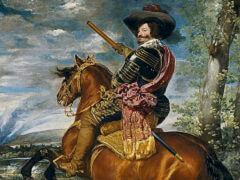Prince Baltasar Carlos with a Dwarf, 1656 by Diego Velázquez

The long-awaited heir to the throne, Prince Baltasar Carlos, born on 17 October 1629, was his parents' (Philip IV and Queen Isabel) pride and joy. While Velázquez was in Rome he attended one of the glittering parties held in many European cities to celebrate the child's birth. No sooner was he back in Madrid than he was commissioned to paint the prince, now sixteen months old, and in another portrait of the same subject he shows the fair-haired little boy with a curious playmate. Dressed in a magnificently embroidered ceremonial robe which makes him into a miniature adult, the prince is standing on a carpeted step beneath a draped wine-red curtain, holding a baton and a dagger in his little hands. The steel gorget indicates his future role as a military commander. His face, expressing all the charm of his French mother in childish miniature, is turned towards another child in the left foreground of the picture, and the child's abnormally large head is looking back at him.
This figure is a dwarf, it is now thought probably a girl, one of the human toys so popular at many European courts of the time. The physically handicapped figure of the dwarf holds a silver rattle and an apple in imitation of an orb and sceptre, and is acting the part of a comic major-domo to the future little king. One wonders whether their Majesties and the courtiers laughed at this picture and the court painter's amusing idea.
The prince's face is modelled with gentle regularity, whereas the paint is applied to the head of the female dwarf with more irregular granulation. This contrasting brushwork is often used by Velázquez in his pictures to accentuate certain features of their content.
In Spain (and other countries too) there was a long tradition of including dwarfs in royal portraits as subordinate figures. Basically, these deformed little creatures were merely attributes of the royal dignity, part of the furnishings of the court and regarded as neuter beings rather than fully human.
















